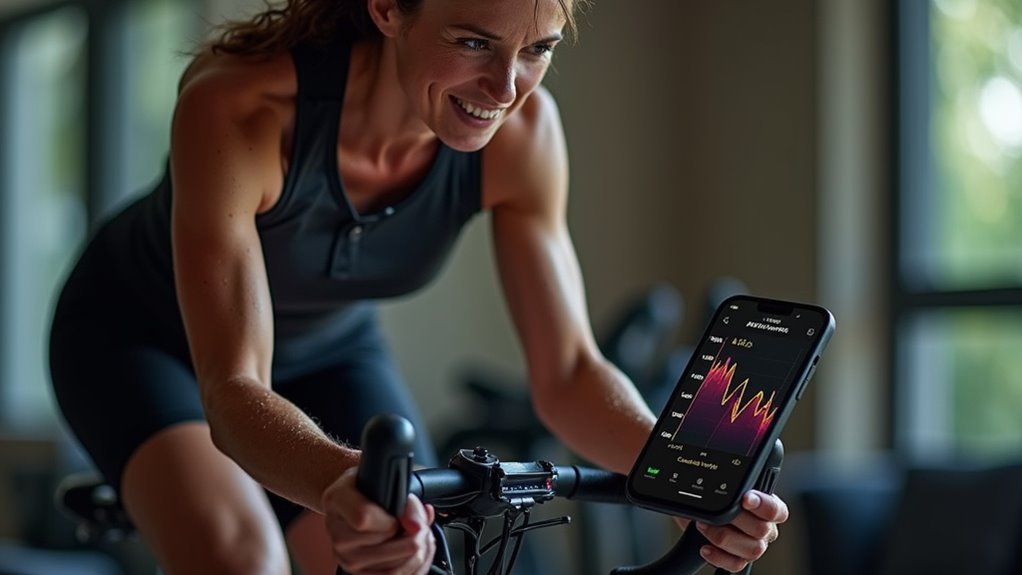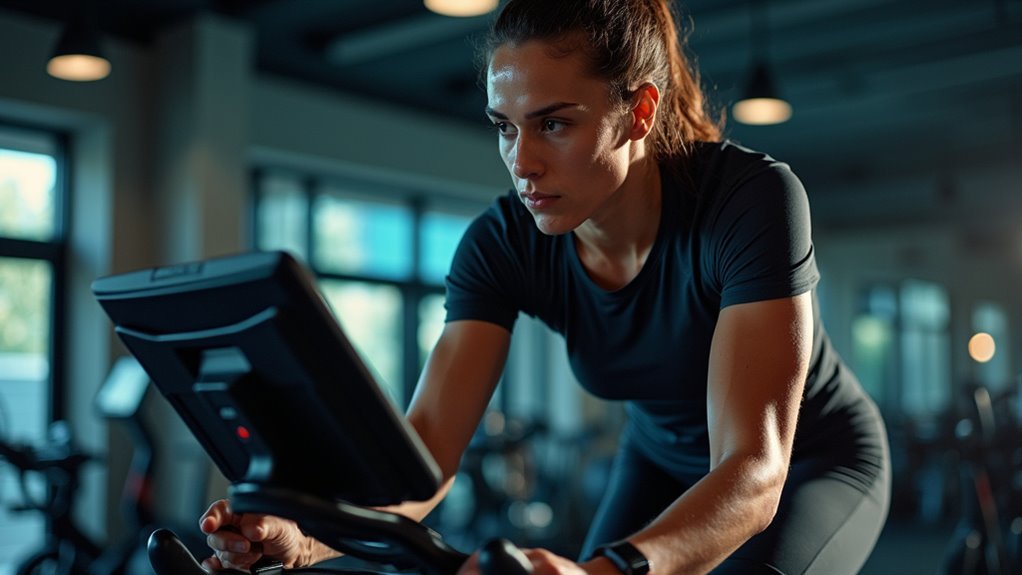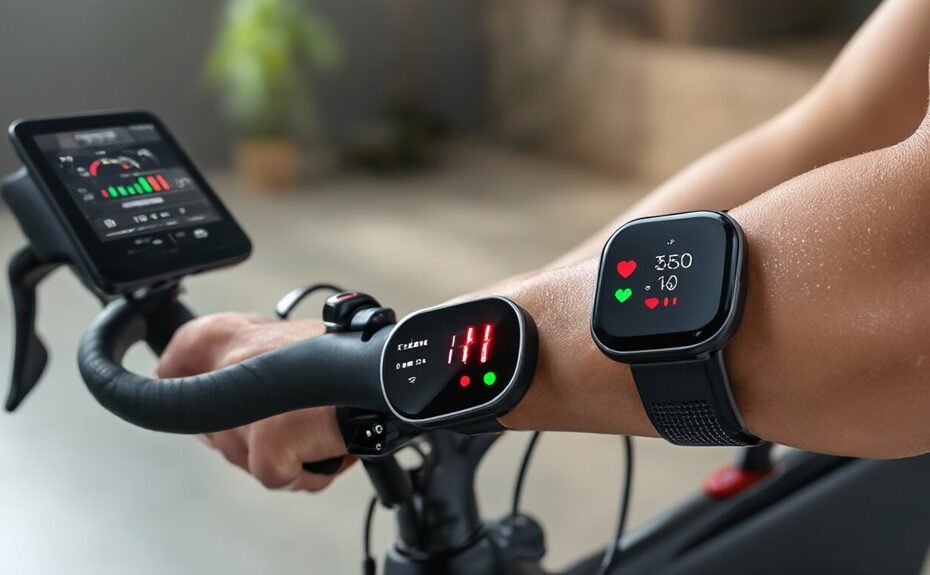Indoor cycling enthusiasts often struggle to find pulse sensors that work seamlessly with their setups. Heart rate monitoring can make or break a training session, and not all sensors play nice with every bike. Some riders prefer chest straps for accuracy, while others can’t stand the feeling and opt for wristbands instead. Connection dropouts during intense intervals? Yeah, that’s probably the most frustrating thing ever. Let’s explore which options actually deliver reliable data without the headaches.
Some of the links in this article may be affiliate links. If you make a purchase through these links, we may earn a small commission at no extra cost to you. Thank you.
Understanding Heart Rate Monitoring for Indoor Cycling
The rhythmic whir of an indoor cycling flywheel provides the backdrop for what’s truly important: your heart’s response to the challenge.
Modern pulse sensors deliver critical heart rate data with remarkable accuracy—within just 1-5% error for premium chest straps like the Polar H10. Today’s heart rate monitors offer dual connectivity through Bluetooth connections and ANT+, making them incredibly versatile for indoor cycling enthusiasts. This precision isn’t just about numbers; it’s about meaningful performance tracking that influences workout efficiency and recovery. Regular maintenance of these devices guarantees they’ll continue providing the reliable data that’s become essential for serious cyclists looking to optimize their training. Incorporating heart health tracking into your routine not only enhances your cycling experience but also supports overall fitness improvements.
Top Wireless Pulse Sensors Compatible With Static Bikes
Selecting the right wireless pulse sensor for your indoor cycling setup demands careful consideration of both performance features and personal preferences.
The Wahoo TICKR stands out for its dual ANT+ and Bluetooth connectivity, allowing cyclists to pair with multiple devices simultaneously during indoor sessions.
For serious performance tracking, Garmin HRM and Polar H10 offer exceptional accuracy—the latter with just 1-5% error margin.
The Polar H10 is widely regarded as the gold standard for heart rate monitors in the bike fitness community.
Budget-conscious riders might prefer more affordable options like Moofit, while those seeking non-chest strap alternatives can explore optical sensors.
ANT+ vs. Bluetooth: Connectivity Options for Indoor Cycles

When cyclists set up their indoor training environment, understanding the difference between ANT+ and Bluetooth connectivity becomes essential for achieving a seamless experience.
ANT+ operates at 2.4 GHz with lower power consumption and allows multiple simultaneous connections to cycling computers and other devices. Bluetooth, while offering faster data transmission, typically connects to just one device at a time.
For iOS users, Bluetooth is the only native option, while Android supports both protocols.
Most modern heart rate monitors feature dual connectivity, like the Polar H10, making them versatile across various indoor cycling setups. This flexibility guarantees compatibility with multiple training apps regardless of your device ecosystem.
Chest Strap Monitors vs. Optical Sensors for Indoor Training
When choosing between chest strap monitors and optical sensors for indoor cycling, users face a trade-off between accuracy and comfort.
Chest straps like the Polar H10 offer superior precision with error margins of just 1-5%, while optical sensors worn on the wrist or arm provide a less intrusive experience at the cost of some accuracy.
Both technologies now feature dual connectivity options (ANT+ and Bluetooth), ensuring compatibility with most indoor cycling equipment and apps regardless of which sensor type matches your training priorities.
Accuracy Between Technologies
As indoor cycling enthusiasts become more data-driven in their training approaches, the accuracy of heart rate monitoring technology has emerged as a crucial factor in performance optimization. Chest strap monitors like the Polar H10 deliver exceptional heart rate accuracy with only 1-5% error margins, while optical sensors often struggle with consistency during intense indoor cycling sessions.
| Technology | Accuracy | Best For |
|---|---|---|
| Chest Strap | 1-5% error | Serious athletes |
| Optical (Wrist) | 5-15% error | Casual riders |
| Optical (Arm) | 3-10% error | Comfort-focused users |
Dual connectivity features provide versatility, making chest straps ideal for cyclists who demand reliable performance metrics and real-time heart rate variability tracking.
Comfort During Workouts
While accurate heart rate monitoring remains essential for indoor cycling, the comfort factor often determines whether cyclists maintain consistent use throughout their training regimen.
Chest strap monitors provide unmatched accuracy but require a snug fit that some riders find restrictive during intense sessions. In contrast, optical sensors worn on the arm offer greater freedom of movement, though they sacrifice some precision in performance tracking.
For many cyclists, personal preference ultimately dictates their choice. Those prioritizing data accuracy typically adapt to chest straps, while others who might otherwise skip heart rate monitoring altogether find optical sensors provide the comfortable middle ground they need for consistent training.
Connectivity With Equipment
Compatibility between pulse sensors and indoor cycling equipment largely determines the effectiveness of heart rate-based training.
Modern chest strap monitors typically offer dual connectivity via ANT+ and Bluetooth, creating seamless integration with indoor cycling platforms. ANT+ technology allows connection to multiple devices simultaneously, while Bluetooth usually limits users to one device at a time.
For serious cyclists using programs like Zwift or Peloton, chest strap monitors provide the most reliable real-time data tracking. Their superior accuracy—with only 1-5% error margins—makes them ideal when precise heart rate metrics matter.
When shopping for sensors, it’s worth checking if your indoor cycling setup requires specific connectivity protocols for compatibility.
Installation and Placement Guide for Optimal Readings
The proper installation of your bike pulse sensor plays an essential role in gathering accurate heart rate data during indoor cycling sessions.
For ideal readings, mount the sensor on the left-hand pedal crank arm, making sure it’s first secured in its protective case. Use cable ties to attach it firmly to the back of the crank arm where it won’t interfere with your pedaling motion.
Tighten all bolts with the provided hex keys to guarantee accurate pulse rate tracking on your performance monitor.
Remember to regularly check and clean the sensor—sweat and debris can affect its accuracy over time.
Accuracy Comparison of Leading Bike Pulse Sensors

Choosing the right pulse sensor for your indoor cycling sessions can make a significant difference in your training effectiveness.
Chest strap monitors like the Polar H10 offer superior accuracy with just 1-5% error margins, while optical sensors such as the Wahoo TICKR Fit provide reliable heart rate tracking with slightly higher variation.
Dual connectivity pulse sensors enhance compatibility across multiple devices and apps.
Budget-friendly options might deliver basic functionality, but they can’t match premium models’ precision.
Remember that electronic interference can affect all sensors regardless of price point, so proper placement is essential.
For serious cyclists tracking performance metrics, the investment in accuracy definitely pays off.
Troubleshooting Common Connectivity Issues With Indoor Cycles
Cyclists often encounter frustrating connectivity issues when pairing pulse sensors with indoor cycles, but most problems can be resolved with a few straightforward steps.
Signal interference typically stems from nearby electronic devices or worn batteries, so creating distance from potential disruptors and performing regular battery checks should be part of your troubleshooting routine.
Pairing failures, perhaps the most common headache, generally respond well to the classic tech fix—turning both devices off completely, waiting thirty seconds, and then restarting them in the correct sequence.
Signal Interference Solutions
Combating signal interference presents one of the most challenging aspects of maintaining reliable pulse sensor connectivity on indoor cycles.
Electronic equipment nearby can disrupt the heart rate monitor signals, compromising your workout experience. To maintain stable signals and enhance connectivity, cyclists should implement several practical solutions.
- Position your indoor cycle at least 3 feet away from other electronic equipment
- Clean pulse sensors regularly with a damp cotton cloth to remove sweat residue
- Restart both the pulse sensor and connected device if readings become erratic
- Check that the heart rate monitor is securely fastened with all bolts tightened
- Consider upgrading to a chest strap monitor like the Polar H10 for more reliable readings
Pairing Problems Solved
Steering through the murky waters of connectivity issues can transform an invigorating cycling session into a frustrating technical ordeal.
When your pulse sensor refuses to connect with your indoor cycle, start with the basics: confirm both devices are powered on and within Bluetooth range (typically 30 feet).
Compatibility is vital—verify your sensor works with your cycle’s protocol. iOS devices lack native ANT+ support, so Bluetooth sensors are often preferable.
Persistent pairing issues? Try restarting both devices and checking your sensor’s battery life.
Sometimes the simplest fix—like replacing a dying battery—is all you need to restore connectivity.
Battery Replacement Guide
The humble battery—small but mighty—can make all the difference between a seamless cycling experience and a workout filled with connectivity frustrations. When pulse sensor readings become erratic or disappear altogether, battery replacement should be your first troubleshooting step.
- Most sensors use CR2032 or CR2025 batteries lasting approximately 400 hours
- Open the sensor cover using a coin, replace the old battery (mind the polarity!)
- Recalibrate the sensor by reconnecting to your device
- Clean the sensor’s electrodes with a damp cloth if issues persist
- Confirm proper fit against skin to prevent connectivity issues
Regular battery checks prevent inaccurate readings and maintain reliable workout data.
Frequently Asked Questions
Which Heart Rate Monitor Is Best for Cycling?
The Polar H10 offers superior monitor accuracy for cycling benefits, with precise heart rate tracking for performance improvement. Its wearable technology provides detailed fitness tracking across training zones.
Where to Put a Speed Sensor on a Stationary Bike?
The ideal speed sensor placement on a stationary bike is on the left-hand pedal crank arm. This positioning enhances workout metrics while avoiding common installation mistakes that can affect sensor accuracy and cycling performance.
Do I Need Both Cadence and Speed Sensors?
For most indoor cyclists, one sensor suffices. Cadence sensor benefits include workout intensity measurement, while speed sensors enhance accuracy. Consider performance tracking importance and potential sensor compatibility issues before installing both.
Is It Worth Having a Heart Rate Monitor for Cycling?
While some view heart rate monitors as unnecessary tech, they’re invaluable for cycling performance. The benefits of monitoring include precise training zones, improved recovery analysis, motivation boosts, health tracking, and enhanced accuracy for peak fitness gains.
